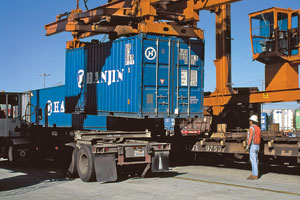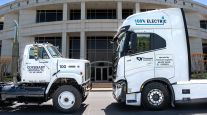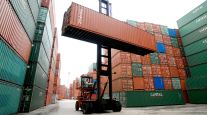Intermodal Volume Setting Record Pace, But Operational Issues Plague Shippers

Just last month, intermodal all-time volume marks were set for most monthly shipments (1.11 million) and most weekly shipments (283,363), according to statistics from the Association of American Railroads. And in the second quarter of this year, truck-rail shipments outnumbered all other freight moving by rail for the first time in history.
“We have a lot going for us. Our achievements are moving us forward,” such as offering drivers more home time than over-the-road jobs, Kevin Lhotak, CEO of drayage fleet Reliable Transportation Specialists Inc., said during an interview with Transport Topics.
But balanced against the good news is a litany of steps needed to sustain the positive trend, a broad range of experts told TT. These include disjointed operations, rail service, chassis woes, capacity issues for trucking and railroads and the importance of technological opportunities.
“The biggest thing that is holding intermodal back is inefficiency,” Lhotak said. And that inefficiency stretches across railroads, truckers, terminal operators and equipment providers, he said.
“We all have to realize we are a piece of the puzzle,” Lhotak said. “There is a problem if three parts are working, and a fourth one isn’t. We are in a good situation if we can curtail those issues. Everyone wins when the system is efficient.
“If a trucker is sitting in a terminal for two hours because of a chassis issue, nobody is getting paid for that,” said Lhotak, whose company is based near Chicago.
But terminal delays are just part of the problem, said Curtis Whalen, executive director of American Trucking Associations’ Intermodal Motor Carrier Conference. Intermodal also is saddled with unreliable rail service, ever-mounting bills for chassis use and questions about driver supply, he said.
“All of that can give pause to someone who is considering intermodal,” he said, but he noted that “all of the fundamentals that are growing the business are still in place.”
“The critical elements for intermodal are rail service and rail capacity,” said Anthony Hatch, an independent rail analyst. “The lack of rail service quality is clear, but traffic still grew reasonably well so far this year.”
Hatch noted that while there was an overall slowdown of 5% to 10% of intermodal trains in the first half of the year, shipments rose 2.3% during that same time span.
Continuing investment in rail capacity is also helping move freight, he added. Those intermodal investments include Norfolk Southern’s capacity efforts near Chicago, Union Pacific’s New Mexico terminal for cross-border freight and Canadian National Railway’s U.S. Midwest service enhancements.
Among the largest investments was $3.5 billion over three years by BNSF Railway to expand capacity between the Pacific Northwest and the Midwest. Upon that project’s scheduled September conclusion, train schedules on the Chicago-Pacific Northwest route will be sped up by one day. But for the moment, trains are still running slower than they were before construction projects began to alleviate congestion.
“Service still isn’t back to base levels,” before U.S. rail delays began in 2013, Hatch said. “Failure to improve that service will severely limit growth.”
Hatch told TT he believes the service levels will continue to improve and that intermodal can increase by adding new routes beyond the core network centered on lanes such as Chicago-Southern California.
But as that domestic work is being done, shipments from beyond U.S. shores also are putting pressure on intermodal. Joni Casey, president of the Intermodal Association of North America, cited a specific growth trend in recent months — the 4.5% increase in international cargo moving by rail and truck in the second quarter.
“We are still getting some unraveling of the backlog,” she said, referring to a surge in Asian cargo shipments after the contract agreement at West Coast ports.
During talks that stretched over 10 months there, delays mounted while labor and management blamed each other for a drop in cargo levels. The port turmoil cut 0.2% off first-quarter U.S. GDP, according to the Federal Reserve.
Even though the contract has been resolved, Hatch and Taylor Howerton, ports and logistics industry manager at SunTrust Bank, told TT that significant port-related difficulties remain.
Ever-larger ships are calling at West and East Coast ports, Hatch said, dumping more cargo from a single vessel into a terminal network that isn’t prepared for such spikes. And Howerton told TT that “truck turn times have slowed” throughout the United States as ship sizes grow and terminal space doesn’t.
“Ports recognize that on-dock intermodal facilities will be helpful” in reducing turn times, he said, along with the opening of so-called inland ports. Those locations provide a pickup and drop-off site several hundred miles inland that’s convenient for truckers, with rail service directly from there to the docks.
Fred Johring, chairman of the Harbor Trucking Association of Southern California, said he has seen truck turn times inside terminals as much as double in recent months.
However, the fact that intermodal growth has continued in the international sector in spite of port terminal congestion is heartening, Casey said.
“We are still bullish, if you will,” she said. “We are finally seeing upticks in the economy. Industrial production is up, housing is up. Retailers that were stockpiling inventory are lowering prices.”
The favorable direction should be maintained despite the rising value of the U.S. dollar that has hurt some exports, she noted.
“We are looking at an uptick in intermodal growth rates above the first half,” she said, without specifying how much of an increase to expect. Maintaining June’s 3.7% growth pace would add nearly 500,000 shipments to last year’s record shipment growth at U.S.-based railroads, as measured by AAR.
Growth also has been achieved, Casey said, in spite of a series of changes in trucking regulations, such as the December suspension of some key changes in the 34-hour restart rule that governs drivers’ hours of service.
“There has been a big focus on whether some intermodal traffic has gone back to truck because of regulatory changes,” she said. “The diversion presumably got a productivity boost when the 34-hour restart was suspended.” But she views this as a short-term episode. “We don’t see that continuing,” she said. “Trucking capacity will tighten up again,” as electronic logging devices and other regulations again squeeze driver supply.
Howerton agreed.
“There are well-known capacity constraints for trucking,” he said, citing the aging driver base, cost pressures such as ELDs and potential reductions from new regulations such as hair follicle testing.
And those cumulative effects highlight the importance of drivers, Casey said.
“Drayage drivers are a very valuable asset,” she said, especially when states such as California and labor groups raise the pressure to turn independent contractor drivers into employees.
“I don’t believe that will necessarily impact the supply of drivers, but it will definitely impact the business model for the carriers,” Casey said.
Whelan noted that intermodal can be appealing to drivers because they can get home more often by working from hub terminals.
However, the sector is still facing the same driver shortage that is plaguing every carrier, Hatch said.
“Driver supply is a problem for trucking, period,” he said, noting that the shortage has led to the creation of bimodal carriers such as J.B. Hunt Transport Services.
Casey believes one positive step would be a standardization of inspection and documentation rules in each city, so that drivers can move faster through cities with many terminals. In Chicago, for example, each of six railroads and many equipment lessors have their own documentation and paperwork practices today.
Howerton and others believe that technological advances also could help.
“Technology can play a big part,” he said. “Solving the problems of terminal congestion will have to rely on information technology and predictive analytics.”
One product that was developed to help improve utilization is Quick180, designed to match exporters’ loads immediately with available containers.
“Exporters were having so much difficulty getting their equipment into and out of terminals due to congestion,” said Ryan Glover, director of sales and marketing for the company Quick180.
“Our Web-based platform facilitates street turns of equipment. We like to call them Quick180s because the turn is accomplished without the empty going back to the port.”
The company’s approach also can help to improve the flow of chassis by keeping that equipment out of the terminal as well, he added.
Managing the movements of chassis can be helped by GPS-based tracking like the Veri
Wise product being offered by Asset Intelligence, a unit of I.D. Systems.
“The technology has been designed and adapted to a very rugged operating environment,” said Matt Harris, Asset Intelligence’s senior vice president. “It’s meeting the need for increasing utilization and visibility of the chassis. With the intermodal business doing well, companies want to operate more efficiently.”
They also don’t want to lose time over issues that are easily addressed, and one of the easiest fixes on a chassis is also causing significant problems: broken light bulbs.
“When a driver goes to pick up a chassis and there is a light out or missing, they know that the replacement process adds hours to their wait time,” said Nancy Eaton, marketing director for lighting manufacturer Optronics. She said the LampLock light uses retaining clips to deter theft, instead of other approaches such as steel plates and rings.
“If a thief tries to pry out our light, the flange parts break away and the light stays there,” she said.
An IANA report earlier this year said that more than 1 million broken or missing lights are being replaced annually on chassis at a cost of $13.5 million. Light problems also are the most commonly cited violation at roadside inspections.
Reliable’s Lhotak noted that significant port delays can occur when chassis with defective lights or tires are offered for service by terminal operators who wrongly expect truckers to fix them.




